Peter Colley Home Page
| |
|
|
Peter Colley Home Page |
Midnight Main Page |
I’LL BE BACK BEFORE MIDNIGHT
TECHNICAL & DIRECTORIAL NOTES
NOTE: The special effects in "Midnight" are quite safe, easy and inexpensive. The exploding stove can be done with CO2 cartridges (like on a sparklets soda maker), and safe prop shotguns are available. You can see the detailed notes below on how the effects are done - and how to easily build Greg's "contraption" and all of the other effects from common items. If Technical Directors have discovered better alternatives, please let us know.

The atmosphere of the play is Gothic. From the moment Greg and Jan enter the farmhouse, the set and the lighting should reflect a shadowy decay, so that when the lights first go up and Jan looks around, the audience can appreciate her lack of enthusiasm for the place.
Pacing is very important in this type of play, and it should be directed at a good clip so that the story moves relentlessly towards its conclusion.
With its moody lighting, and spooky sounds, it is lots of fun to stage technically, but not beyond the capability of even small theatres.
It does take a little more planning than the simple "talking heads" type of play, but the results can be well worth the extra effort and is not out of reach for even the most primitively equipped theatre.
One important point regarding the big ‘jumps” and the scary sequences that occur throughout the play: these take more rehearsal time because the timing is so important, so extra time should be scheduled for these sequences. Thrillers are different in this respect from other kinds of play. Also, since a number of the key scenes are played in low light it is important that the actors be given ample time to practice in those conditions.
CHARACTERIZATIONS
JAN: Age 20-30. Pretty, delicate and vulnerable, a very trusting soul, which draws the audience into the story.
She's in the mold of Audrey Hepburn in "Wait Until Dark" or Mia Farrow in "Rosemary's Baby.
She's the key to making the story work. She has come from a psychiatric hospital, but she is the sanest person in the play. There can be the temptation to play her as overly neurotic. She has recovered from a nervous breakdown, but the key word is “recovered”. There are chinks in her armour but she is essentially a rational, functioning human being. In fact the audience should relate to her very strongly, and admire her spunky spirit. She is insecure about a number of things, but as the play unfolds it becomes obvious that she has every right to be.
GREG: Age 25-35. Greg is a Ph.D. student, though he should be quite handsome despite a stiff academic exterior.
There's a repressed sexual tension that runs throughout the play, especially when Greg's sister arrives.
The danger with Greg's character is to “telegraph” the end of the play.
Ultimately Greg is a bad guy but that must come as a surprise. Jan isn’t stupid; she cares about this man for a reason so he must exude a quirky charm.
He must give us enough glimpses of affection toward Jan that the audience excuses his detached persona and insensitivity, and are still rooting for their marriage to work.
You don’t want people thinking “what the hell does she see in that idiot?”
Greg must also have a certain sexual charisma. If he looks too much like an egghead the audience will not accept the fact that two intelligent and attractive women are fighting over him.
LAURA: Age 25-35. Laura should be strikingly beautiful, cool and distant by nature, although very capable of turning on the charm when she feels it will serve her purpose.
She is a businesswoman and has little time for Jan's vulnerability, although in her own way she is just as vulnerable.
The problem here is playing her mono-dimensional. She can easily end up being the classic soap-opera bitch, but it should be played against that.
What she says and does is bad enough without spitting all her lines out. Laura is a human being too.
Her great sin is wanting one man too much. It is best to play against the lines.
In her scenes with Jan she should be all sweetness and light as that makes it
easier to hide her true intensions. That is what gives such sting to what she actually says.
GEORGE: Age 40-70. George is the comic relief - on the surface
he's a loveable old farmer who loves to spin tall and horrendously morbid tales - especially to gullible city folk.
He has a raucous laugh, especially at his own jokes. He should be loveable, but a little odd.
He develops a warm relationship with Jan but he has his own demons too. George has been played many different ways, and many of them work well.
He can be large and slow-talking, or skinny and hyperactive. It just requires an actor with a good sense of both comedy and drama - especially comic timing.
DETAILED NOTES
ACT I
Incidental and Underscore Music
The mood can be set with pre-show taped music. Like all the music used between the scenes it should be dark, brooding music with a powerful sense of foreboding.
The use of organ music can be a bit too Gothic. Strings seem to capture the mood best, and there is also some excellent stock music available on the web, some of which has been composed for use as soundtracks for film.
Some directors like to underscore the high suspense moments, and this can be very effective if done judiciously.
There are pre-existing music and sound effects CDs made for previous productions of the play available for rent.
Please contact the author for details. The music used between scenes should build in intensity as the play progresses.
The Car Headlights
Act I - Scene 1. Top of play. This effect is best achieved with someone in the wings outside the window holding a powerful hand-held light, and slowly moving it across the window to simulate a moving car pulling up in the driveway.
The Darkness
Act I - Scene 1. Opening. The only time there is complete darkness on stage is between the scenes.
During the actual scenes when the lights are supposed to be off there is always a small amount of light.
Depending on the scene, the amount of fill-in light varies, and will be discussed as each scene comes up.
The opening darkness can be quite dark, as there are no points of information necessary at this stage.
The hallway should be quite dark, and if the set design includes a window in the hallway (see the ground plan) then it would be nice to see the silhouette of Greg and Jan before the lights go on.
The Lights Come Up
Act I - Scene 1. Opening. Try not to give the set that overlit, washed-out effect of a drawing room comedy. Try to use small desk and table lamps and light the room naturally, so that some areas are darker than others.
The Sliding Hatch
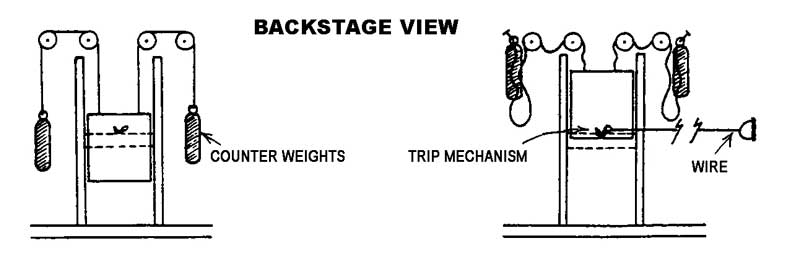
* Rub a candle on the wooden runners if it sticks too much.
In ACT II, Scene 3, where the hatch “accidentally” slams down, the technique is to take up the counter weights and have a trip mechanism controlled by a wire or rope. NOTE: For safety make sure that Jan does not put her head through the hatch before it is triggered.
The Wood Stove
A pot-bellied stove is the best, although any woodstove can be used, even a simple square box style. If you use the air cannon for the explosion (see below), then the stove can even be made of wood if a real one cannot be found. The stove on the right, below, was made out of sheet metal by the props department.
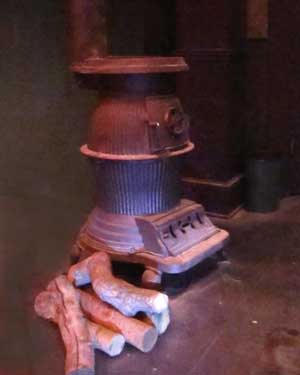
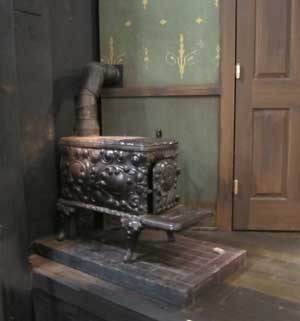
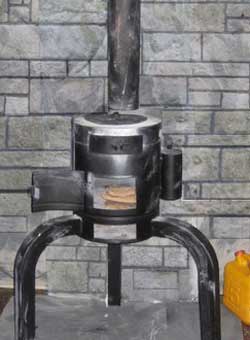

Various types of wood stoves used in the play.
The Exploding Stove
Act I - Scene 1. If this effect works well you’ve got the audience spooked already.
The set explodes! What’s next? However the audience knows it’s going to blow because of the set-up, so don’t disappoint them. A feeble little “phhut” may not meet their expectations.
There are many ways to achieve this effect.
In the past a flashpot in the stove did the trick nicely, but today it is harder to use explosives on stage legally.
Flashpots and firing systems are still usually available to rent or buy and they
are still the best - so if your theatre can handle it, go for it.
The cheapest (but less effective) alternative is to fire a blank into a large tin can off-stage.
Another cheap method is to pop a large balloon inside the stove or offstage.
(SEE EXAMPLE FURTHER DOWN THE PAGE). These may need to be augmented with a sound cue.
Quite effective and very safe (and often cheaper than a flashpot) is to use a magician's air cannon which uses inexpensive CO2 cartridges to shoot confetti and streamers.
As these do not use live flame they do not have to meet the requirements that pyrotechics require.
Certain models can be adapted to make a loud bang, like the 2" Air Cannon
shown (that model has been discontinued and was available for $139 including a 25' remote control
and has been replaced by the 2" Mega Mortar for $199 at www.aerotechnic.com
- and for a slightly higher price at www.theatrefx.com.
The latter web site also has a 1" barrel cannon (AE12) with 25' remote for $149 which
we haven't tested yet but they have assured us will also give a good
"bang" effect with a slightly higher pitch than the 2" cannon.
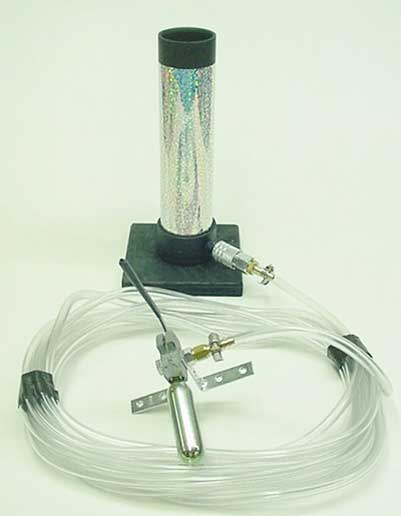
The Air Cannon supplies are usually cheaper than using a squib. They require a CO2 cartridge (around $1 - $2.50 per cartridge) and inexpensive small cardboard "Back Pressure Caps" (2" caps $6 per dozen, 1" caps $3 dozen) and "Lifting Cups" (2" cups $12 per dozen, 1" cups $6 per dozen). These can be obtained from magician's and special effects stores on the web. Masking tape or gaffers tape (best) is needed to tape down the caps.
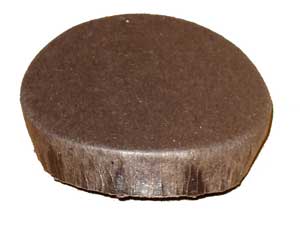
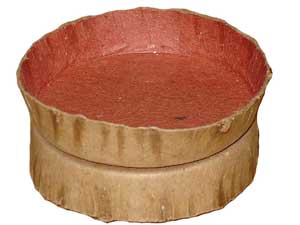
Pressure Cap and Lifting Cup
http://www.theatrefx.com/cannon-parts-accessories.html
In larger theatres, the explosion may need to be augmented with a taped sound effect.
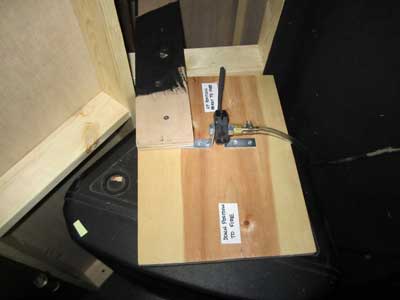
Backstage Air Cannon Trigger
DETAILED INSTRUCTIONS FOR AIR CANNON
1. Take a 16 gram CO2 CYLINDER and immerse in warm tap water (less than 140 degrees) for at least 10 minutes prior to inserting into the firing valve. Low temperatures can significantly reduce the output.
2. Lift AIR CANNON out of the wood stove.
3. Insert the LIFTING CUP into the Air Cannon tube. This is the brown double-sided 2" cardboard shallow cup. You will need to squeeze the bottom of the lifting cup to make it fit into the tube. Push it to the bottom of the tube with the plastic pusher rod.
4. Add a tablespoon of ash to the tube - burnt paper ash is the best.
5. Install the BACK PRESSURE CAP. This is the 2" black cardboard cap which fits over the tube. Take about 18" of 1 1/2" masking
or gaffers tape (gaffers is best) and wrap it two full turns around the Back Pressure Cap making sure that the top of the tape is exactly on the top edge of the Cap. Any deviance may cause one side of the cap to lift off first, resulting in a hiss rather than a bang. Take 3 pieces of approx 9" of masking tape and criss-cross the tape over the top of the cap. Carefully press down the masking tape.
6. Place the air cannon back into the wood stove.
7. Screw the CO2 CYLINDER into the threaded hole in the TRIGGER VALVE. IMPORTANT: The Black Lever must be in the "Up" position before screwing in. WARNING: At this point the device is activated!
8. FIRING. To fire the CO2 properly the trigger must be forcefully and quickly pushed all the way down. The cylinder will be very cold after firing. Be careful not to touch it until it has warmed up.
If your theatre can safely use real pyrotechnics with squibs / maroons / flashpots - that usually achieves the most powerful effect.
The Flashpot
The Flashpot is an electrically insulated and fireproof box that the squib goes in.
They may not be legal in all areas. Check with your local authority. Commercially available flashpots are the easiest
option and give the most realistic bang.
The Squib
In the UK, squibs are called “maroons”. Commercially available squibs/maroons are available in a range of sizes.
As laws have been changing in recent years please consult with a pyrotechnics expert for the most recent safety regulations.
Blowing The Lid Of The Stove Up
This is not vital, but it can be fun. If the air cannon is aimed at a wooden lid that is tethered, it should pop it at least part open and a cloud of "smoke" from the ash should emerge.
The lid should be weighted enough so that the cardboard caps of the air cannon do not emerge from the stove.
If a squib is used it can be sized so it blows up the lid.
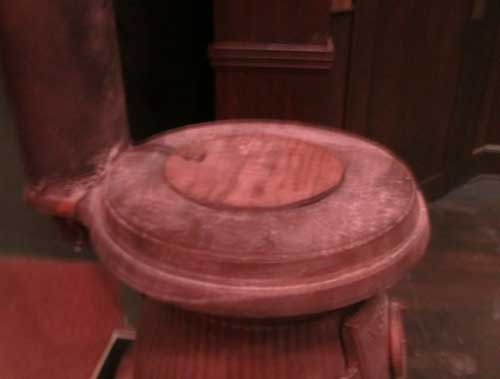
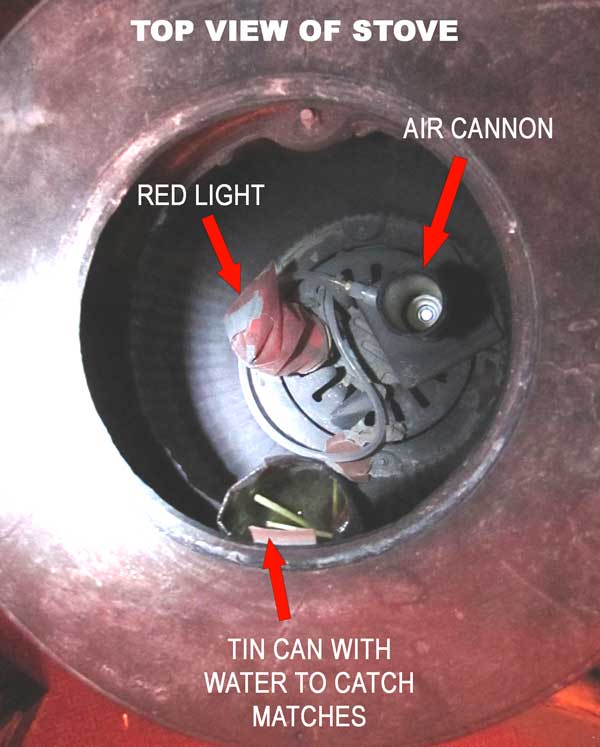
If an air cannon is used, a red light inside the stove can add to the effect of an explosion. A tin can with some water in it can catch the match which Greg drops into the stove.
THE BALLOON TECHNIQUE - with my thanks to the Lompoc Civic Theatre who used the following easy-to-construct method.
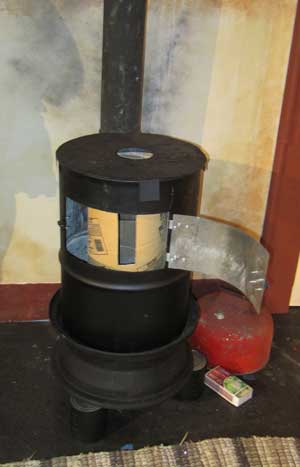
A metal drum sitting on a wheel rim with a cutaway front.
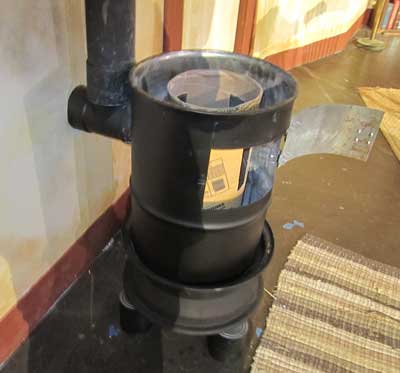
The horizontal pipe is used to puncture
the balloon with a stick from backstage.
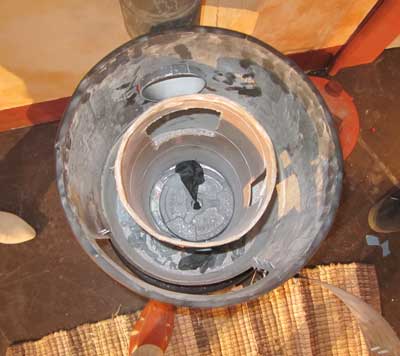
You can see the remnants of the balloon
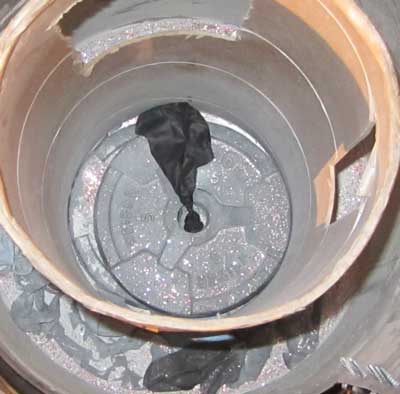
There were two weights on top of the balloon
to create the sound.
The holes in the sono tube are to let the sound out. This is not as effective as some of the other methods as it does not create smoke, nor does the top pop off, but it is easy and safe.
Greg's “Contraption”
Act I - Scene 1. The biggest problem is usually that the contraption is built too small and it does not have enough impact when it is triggered.
The base and the swinging arm should be at least 18" long, and if you can't get the arm to swing down with sufficient velocity you could add a spring, as shown below.
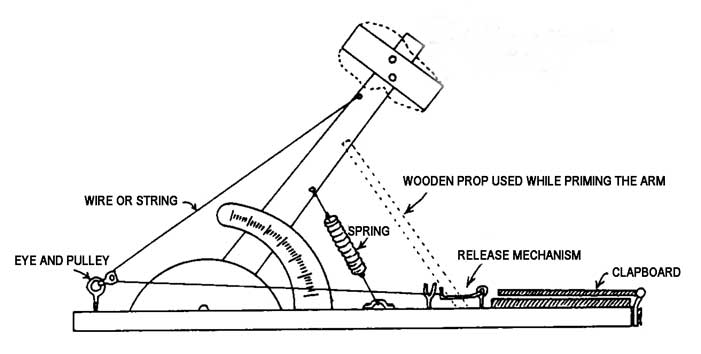
For extra safety, you can use a rubber mallet, covered with a wire frame and paper maché to simulate a rock.
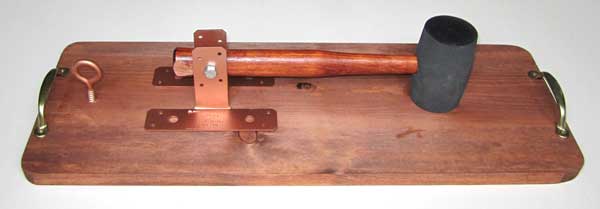
If you are pressed for time and resources, a fake rock on the end of the swinging arm is not vital. You can use just the rubber mallet but it should be sprayed silver to look like metal. The fake rock is very easy to construct as shown below:
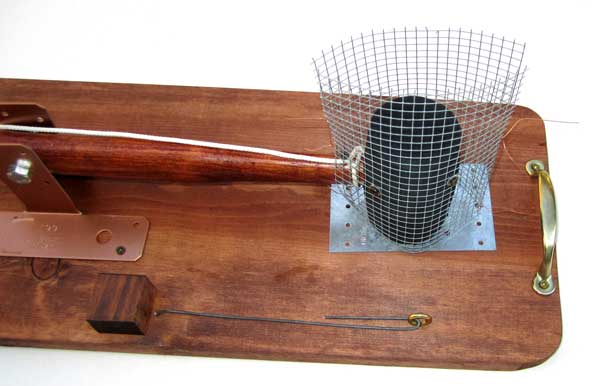
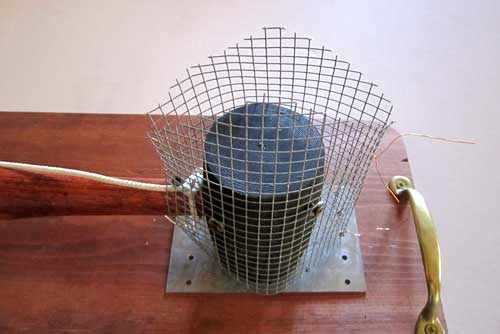
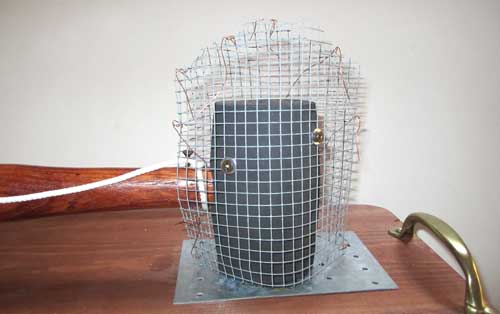
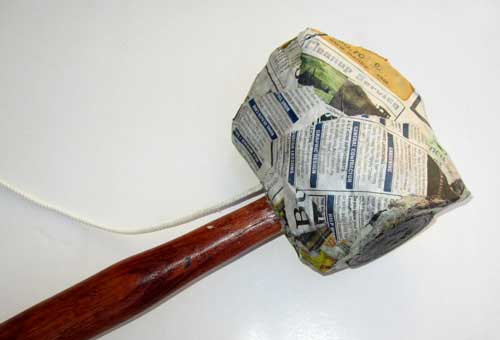

The triggering mechanism must be placed in such a way that when George puts his mug on the base it triggers the arm without hitting his hand. The trigger can be as simple as this:

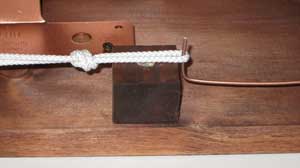
The contraption can be fancied up with fake gauges and calibrations for additional effect. The one in this version is made from a cheap plastic angle finder and then painted with bronze spray paint.
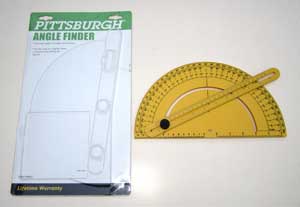
To increase the sound, the metal strike plate can have another piece of metal placed on it as a kind of “clap-board”. The easiest is to use two strike plates loosely screwed down.
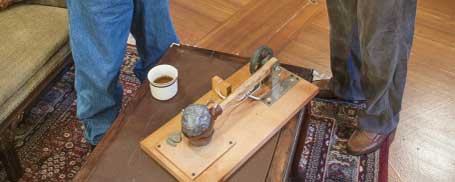
Here's a version from the Cortland Repertory Theatre
The Hatch Jolts Open
Act I - Scene 1. This can be a real “jumper” for the audience if it’s done properly.
The key is that Jan must back up right next to the hatch but looking toward the hallway. This keeps the audience’s focus away from the hatch until it jolts open right behind her.
Spilling the Coffee
Act I - Scene 1. Just use a cup of lukewarm water. It drops too fast for the audience to see it (they are also distracted by the knock on the door), and when it soaks into cloth it looks dark like coffee.
The Contraption Hits George’s Mug
Act I - Scene 1. It may not be possible (or particularly safe) to demolish George’s mug.
That is only for the adventurous director and actor. Provided the arm comes down with enough of a whack nearby, the desired effect will be achieved.
The Flint Axe
Act I - Scene 1. Make this a decent size: at least two feet long in the handle.
The axe that is used in the final scene of the play can be made of a variety of materials, except of course, stone.
Try to make it as realistic as possible without making it a deadly weapon.
One of the best methods is to make the axe that Jan attacks Greg with out of foam rubber.
Properly shaped and painted it can look realistic even from a few feet away.
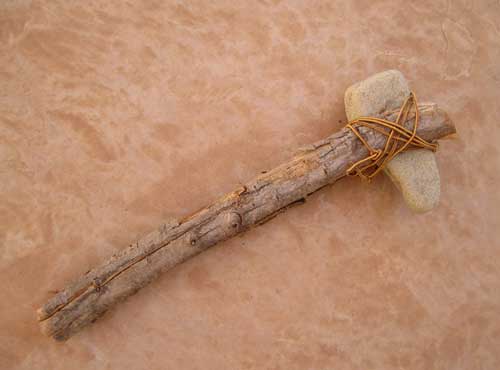
All the other Stone Age weapons can be made from real rocks lashed into the cleft of a stick and bound with leather thongs.
This is pretty much how the Stone Age men made them.
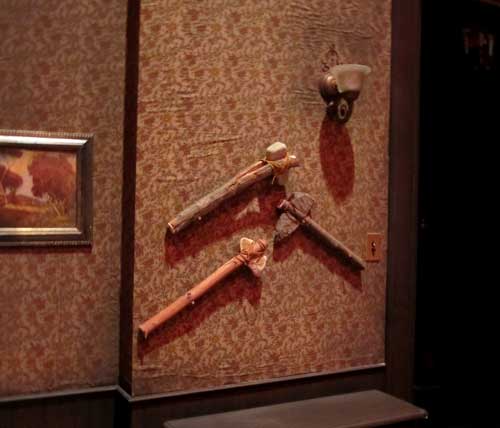
Can you spot the foam rubber axe? It's the one on the right.
Arrowheads
Reproduction arrowheads can be bought cheaply on Ebay and other web sites.
They can also easily be made from paper maché or wood and mounted in simple
frames.
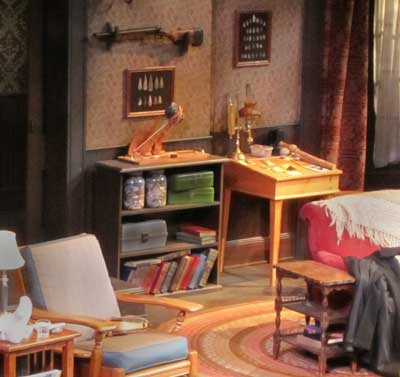
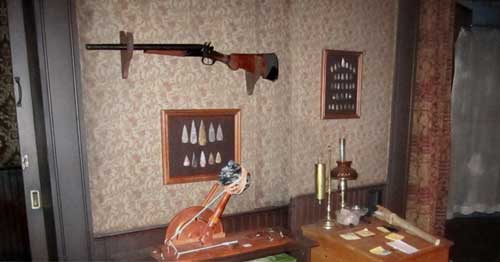
Lighting in Scene Three
Act I - Scene 3. The lighting should be particularly spooky during this scene.
As it is very late at night bright interior lighting should be avoided. A few well-placed practicals (desk lights, sconces, etc.) with the bare minimum of fill-in lighting should give the desired atmosphere.
The Heartbeat
Act I - Scene 3. This may sound a bit corny, but it has a remarkable effect on an audience. Start it quietly, almost imperceptivity, and build in volume and tempo.
The Scratching at the Window
Act I - Scene 3. It is very hard to approximate the sound of fingernails scraping on glass and have it heard throughout the theatre. Styrofoam (polystyrene) makes some interesting noises. What has worked in a small theatre is a houseplant size rake (a clawlike tool about six inches long) scraped over brick or glass.
The Black-Outs
Act I - Scene 3. The credibility of the two black-outs in this scene are crucial to maintaining the suspension of disbelief and to make the audience feel like they are actually in the room. There should be a faint blue light coming in through the windows. Anyone who has lain awake on a moonlit night will recall that the light only comes in through the windows - too much use of overhead blue lights makes it feel like you’re in a field rather than a house. It may be necessary to cheat in a little more fill-in light in the final scenes because the action becomes more frantic and there is more to see. In this sequence (Act I, Scene 3) there is nothing the audience has to see, but some things they mustn’t see. If you are in doubt make the black-outs in ACT I very dark, with only the faintest light delineating the shape of the windows. A shaft of moonlight is a very atmospheric effect, catching the edges of furniture and filling the room with ambiguous shadows.
Use of Incidental Music
Act I - Scene 3. The first entrance of the hermit (George in disguise) is a good time to use incidental music/sound effects like in suspense movies. In terms of logic, one could say that it had been added to the heartbeat tape by whoever is trying to drive Jan crazy. It can heighten the tension and can be very powerful in adding suspense. It is useful in this scene because the first entrance of the hermit is one of the most difficult scenes to make work well and the use of the soundtrack can help push it over the edge.
The Window Is Blown Open
This is achieved by having a rod attached to the bottom of the window so it can be opened and closed from the wings. A fan in the wings blows open the sheer curtains (the heavy drapes are open). The blue-gray moonlight also streams in through the window.
The Big Hermit Scare
This is one of the biggest scares in the play if done right, but it is tricky. It requires a distraction when George sets himself behind the sofa. This distraction is done by Jan (and the audience) focusing on the window which has blown open in the wind. Crouching low in dark clothes George slips in through the doorway of the double-doors and sets himself.
The second distraction is when George pops up from behind the sofa. The audience's focus must again be elsewhere. Jan can use the flashlight to look around the room and then hears a sound at the window. She wheels around to look towards the windows with the flashlight and then the hermit (George) pops up right in the beam of the flashlight as though he has appeared from nowhere. This moment can be augmented with a sound cue. When Jan faints and drops the flashlight, he can escape back through the doorway.
The hermit must not look like George as that would give too much away, so the actor should do all he can to change his appearance. He can hunch over to change his height and posture, and change his gait with a limp. Also the baggy hermit coat can hide his body shape.
The Hermit's Weapon
George mentions that the hermit appears with "a long bloodstained knife". This should be a good size, like the various field knives used in farm work. Some look like machetes, some have a hooked end for cutting crops like a sickle.
The Flashlights (Torches)
Act I - Scene 3. The flashlights (called torches in the UK) should be powerful and rugged ones. They will get some abuse. Also it is very important that spare flashlights (at least two) are hidden around the set, and that Jan practices getting them in the dark. If you only have one flashlight it is guaranteed to fail on opening night. And the batteries should be fresh.
George’s Face at the Window
Act I - Scene 3. This can be a deceptively big scare. The key is to have George’s face “pop” into the window and have the face well enough lit. Because of the low light on the set at this time it will be most effective if Jan's flashlight illuminates his face when she opens the window searching for clues.
Laura’s Entrance in the Dark
Act I - Scene 3. This blackout should be the darkest in the whole play. Because Laura is often clothed in a white satin nightie she can be seen easily in even the lowest of lights. It is vital that the audience does not see Laura before the lights come back on, and the best way to achieve this is to have Laura come down with a black dressing gown over her white satin nightgown. If they see her it ruins a great moment. If necessary the lights should be cheated very low for Laura’s entrance. When Laura "falls" after the shot, she can let the black dressing gown slip off so that her white satin nightie is visible when the lights come on.
The Shotgun
In the past, shotguns were easy to use on stage. Since 9/11 rules have changed and there may be extra regulations to deal with.
If you can use a real shotgun with blanks it has the best effect. In the U.S. and Canada companies have recently been using a replica shotgun made by Denix (model 1115).
This is available to purchase on the web - and can often be cheaper than renting a replica from a prop house. It costs between $120 and $170 online, so it pays to shop around.
It's a useful prop to have around for shows like "Oklahoma!" - in fact any local theatre that has recently done that musical may already have one that you can use.
It is currently $129 at www.knifecountryusa.com

As a non-firing prop gun, it has far less restrictions than a real gun, and since the shotgun mentioned in the play is supposed to be old the Denix looks appropriate.
Also the Denix is an 1881 design so it is usually free from many of the restrictions of modern guns.
It's a good idea to check the local gun laws as they are always changing. The Denix is a "coach gun" so it is a little shorter than a regular shotgun, but it looks fine.
Other theatre companies have made a prop shotgun out of wood and fired a blank offstage which is not as effective, but still works.
Of course, if you can legally use a real shotgun with blanks - that's still the best.
The Shotgun Blast
Act I - Scene 3. In the past, you could have a blast that would send a shower of sparks across the room.
Today, firearm laws everywhere have been tightened so that may be much more difficult.
If you can legally use a blank that's the best. Naturally Jan must aim it well away from Laura.
The Denix shotgun is a hammer-action where a hammer hits a percussion cap. You see a nice spark from the hammer though not from the barrel. It works quite well, since the scene is in blackout, so any kind of spark in the dark indicates a gun going off.
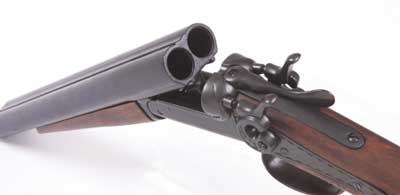
Some types of percussion caps for toy guns or cap bombs will do and these can be found very cheaply on the web.
The caps that come in rolls are not as effective as the ones in strips of small red plastic cups.
In a large theatre the sound of the cap may need to be supplemented with a sound effect.
With the Denix shotgun, the percussion caps need to be taped onto the nipple with two strips of black electrical tape along the sides.
If you use toy caps the nipples on the Denix shotgun may have to be filed down to fit the small caps.
To find the more powerful caps you can use PFC (Plug Fire Cartridge) caps.
You can search the web for "7mm pfc caps". In previous productions theatres have used "Realflame 7mm caps" which work very well, though they can be hard to find.
PFC caps are also manufactured by Marushin and MG.
These may not be allowed in every area so check before ordering. You can
try: www.plugfirecapgunsuk.com
To date, there does not seem to be a safe way to get a muzzle flash from the Denix prop
shotgun, if any technical director knows how to safely achieve this, please let
us know.
Whenever any gun is used on stage, safety practices must be adhered to. With regular shotguns, pyrotechnic or firearms certificates may be required, and the local police may have to be notified.
When the Stage Manager puts the blanks in the gun it is wise to do this in the presence of the actors and allow them to double-check the blanks.
Alternatively the Stage Manager can give the blanks to the actor/actress who is being fired at, and let them examine the cartridges and load the gun.
From then until the gun is placed in its rack on stage it should not be out of the Stage Manager’s possession.
The procedure should be followed between the Acts and every night. These may be out-of-date instructions so check with a licensed pyrotechnics expert on the most recent regulations.
In Act Two when George checks the shotgun and "switches" the bullets, he does not need to actually take the cartridges out - he can hide that switch with his body.
ACT II
Blood on the Floor
Act II - Scene 2. It’s not absolutely vital to see the blood on the floor, but it is very effective if it can be done and gets a big reaction from the audience, especially when Jan wipes it with a cloth and it has a bright red stain on it. This can be achieved in a number of ways, depending on your theatre.
The simplest depends on whether you have under-floor access, and can drill a hole in the stage floor.
That would go like this:

If you have no access then the tube has to be run under the sofa and the carpet.

The usual location of the blood is in front of the sofa - the location is pointed out by George in Act I. A great amount of blood is not needed, just a tablespoon, but if the effect is working the audience will all crane their necks to see where it is, so make it visible. The tube should be a thin, flexible, plastic tube. I.V. bags can be used for storing and squeezing out the blood, but a number of other things can be used, like a plastic syringe which can be pumped when needed.
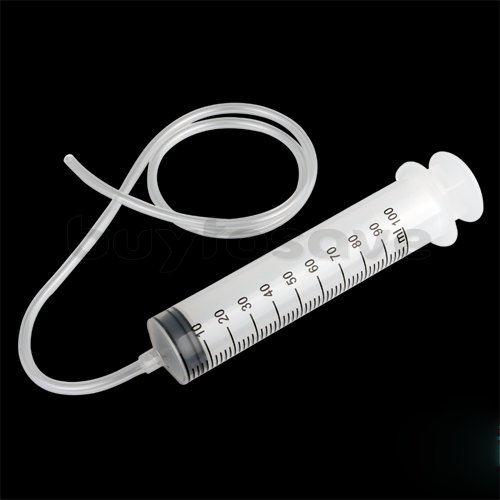
The Hand From the Window
Act II - Scene 2. The timing of this sequence is critical. Don’t telegraph the hand, as it should be a complete shock.
Almost as soon as Jan closes the curtains and turns with relief, the hand should dart out and grab her by the throat.
She should have to struggle to get free and then of course she runs straight to the door and that’s where the audience gets hit with the second big scare.
How does the hand get there? There are several ways of doing this. There are two versions in the following diagram:

"A" has a downstage opening, and "B" (simpler) has the actor slip in through the window while the curtains are closed and wait in the corner of the bay window, hidden from the audience by the downstage drape.
The Corpse
Act II - Scene 2. Just use the actress playing Laura as the corpse. More than one theatre has gone to great expense to make a dummy corpse only to scrap it later. Dummy corpses just don’t look as effective as the real thing.
Laura does not have to be actually hung. She stands on a small box that is the same color as the set behind it, and her ragged nightgown covers the box.
She can sway slightly and this simulates a dangling body very effectively.
Even in a small theatre the audience is often amazed to hear she wasn't actually hanging.
The noose around her neck is separate from the dangling rope and just connected by a small piece of velcro that would come away easily.
The Hatch Slams Shut
Act II - Scene 3. See earlier description of hatch mechanism.
The Banging on the Double Doors
Act II - Scene 3. This should be a loud, sudden, banging timed to come almost as soon as Jan puts the phone down.
It should shake the whole door and scare the audience with its suddenness.
Smashing the Window
Act II - Scene 3. There’s no need to actually smash the window - a "crash box" full of broken glass works well.
Even a taped sound effect can work as an alternative. A crash box is a wooden box full of broken glass, one or more sides of which is open and covered with mesh.
This allows the sound of the glass to get out when the box is tipped or shaken.

Greg's Shovel
The type of shovel shown below is the easiest to use in the fight. It should be full-sized.

The Choreography of the Flashlights / Torches
The flashlights are very important, especially in ACT II, Scene 3. What the light from the flashlight does in this sequence is the same as a close-up does in film — it focuses the audience’s attention on specific details: the knife, George’s face, the shovel.
It is especially important in the last scene of the play to have the movement of the flashlight beams carefully orchestrated. Both Greg and Jan use flashlights.
George’s Big Jump
Act II - Scene 3. When Greg shoots George he should fall behind the sofa where the audience cannot see him.
Then Greg and Jan have their short scene, and George leaps unexpectedly from the shadows.
This is a scare which is often telegraphed. While it is a bit scary to see George slowly stirring and getting up, it is not as effective as him just leaping at them out of the darkness.
This is easily done if George is hidden behind the sofa and Jan and Greg are talking quite nearby.
The Big Fight
This should be very energetic. It needs plenty of rehearsal time and also quite a bit of practice in low light.
It is definitely possible to have a rip-roaring fight and still keep it safe.
There are two big moments in the fight. The first occurs when George is thrown on to the sofa and Greg raises the shovel to hit him while he is prostrate. George rolls off the sofa on to the floor and the shovel impacts the empty sofa with a mighty thump.
Greg should make sure that George is clear before he starts the downward thrust. In low light it really looks as though it JUST missed George.
The other big moment is when George falls behind the sofa or chair and we see Greg bringing the shovel down on him again.
The trick is to have a cushion velcro’d to the back of the sofa and George grabs it and lays it down next to him on the floor.
It is this cushion that Greg attacks with such vigour and it should sound very much like the shovel is hitting George.
Greg "Strangles" Jan
It is important that we see this even though the scene is dark. Jan can still be holding her flashlight so she can angle it upwards while she is being strangled in such a way as it illuminates them both.
Later, after Jan appears to be comatose, Greg can hold a flashlight to her face.
George and Greg’s Scene
George brings a candle in and places it on the table. Then the stage lights can cheat up in that area to fill in. Jan, meanwhile, has to remain forgotten in the shadows until she comes out at the very last moment.
She can be visible, but unobtrusive.
These days it is possible to use very realistic battery-operated candles that don't use live flame where live flames are prohibited. They are available on Amazon for around $10, but if you desire a really good one with a realistic flickering open flame you can get on for around $50 from www.theatrefx.com.
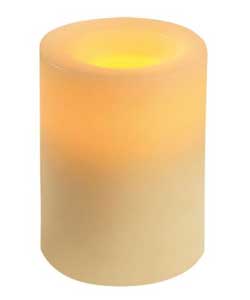
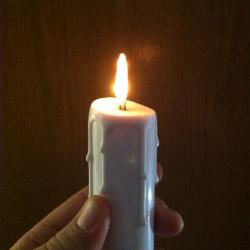
The Killing of Greg
When Greg goes off-stage to get the hermit outfit he has to go through a fairly quick change.
He has to slip on the hermit coat with the axe built into it. The axe can be secured inside the coat with a harness made like this:
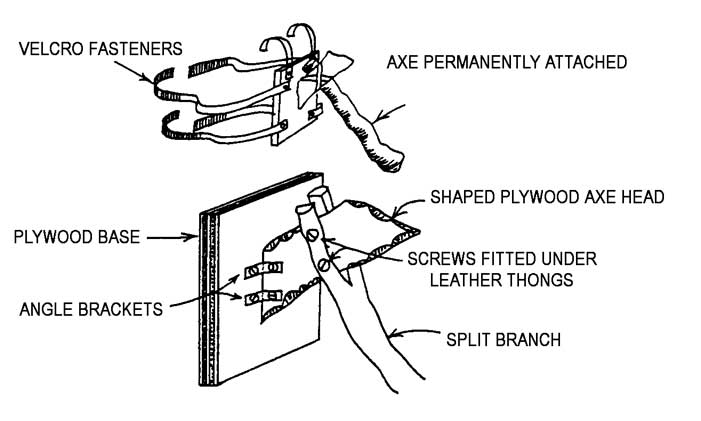
The coat and axe should go on as one piece for the quickest change. The coat has a slit down the back through which the axe fits.
Then for the brief moment that Greg returns on stage he keeps his back away from the audience.
Jan attacks him from behind with the "soft" axe she has taken off the wall.
She can hit the plywood back of the coat and then, masked by Greg's body, drop the "soft" axe behind a chair or sofa.
For theatres that have thrust stages where sight lines may show the axe being dropped, it is possible for Jan to stand in the doorway, draw back the axe, and then appear to rapidly bring the axe down with a cry, while a stagehand standing just behind the wall by the double doors has taken the axe out of her hand just before she brings the axe down.
That takes careful timing, but it has been done reliably and the illusion appears to work.
After the attack Greg staggers a couple of steps forward, turns to look at Jan and realizes he has been outwitted, then finally slumps over the back of the sofa revealing the axe embedded in his back.
Greg’s Final Speech on the Tape Recorder
This can be on a pre-recorded cassette in the portable tape recorder, with a backup on the main sound system, or just on the main sound system.
It sounds more realistic if the sound seems to come from the portable tape player itself, so if it is possible locate a speaker near the tape recorder.
If the tape recorder does not have a small red LED (Light Emitting Diode) light that goes on whenever the "record” button is pressed then one can easily be simulated using a small battery-operated LED light and a red gel.
The Curtain Call
It’s been a heavy ending but it’s over, so the curtain call music can be made more light-hearted by using some up-tempo music.
It reminds the audience that it’s only a play.